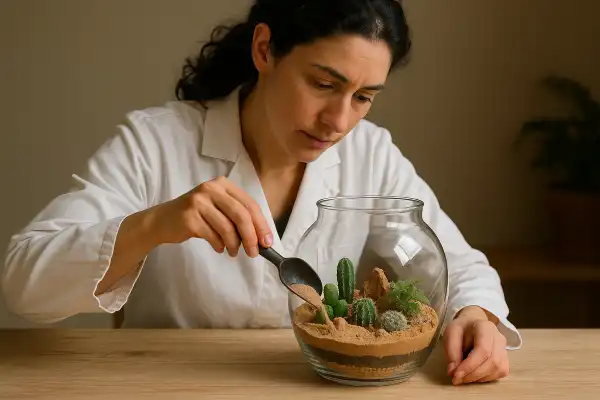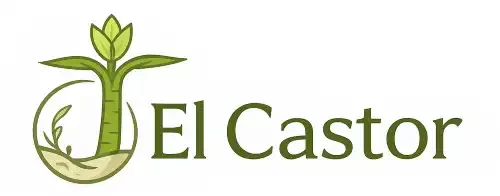Many plant enthusiasts find themselves curious about how to make a desert terrarium when they want to bring the stark beauty of arid landscapes indoors. This question often emerges from a desire to create something both visually striking and low-maintenance, especially after struggling with humidity-loving tropical plants.
Desert terrariums offer a compelling alternative to traditional closed glass gardens, mimicking the resilient ecosystems where cacti and succulents have adapted to thrive. The appeal lies in their sculptural beauty and the meditative quality of watching these remarkable plants flourish in controlled, miniature environments.
How to make a desert terrarium?
Creating a successful desert terrarium requires an open container, excellent drainage, and the right combination of arid plants that can thrive in dry conditions with minimal humidity. Unlike traditional closed terrariums that rely on trapped moisture, desert versions must prioritize airflow and drainage to prevent the root rot that quickly kills cacti and succulents.

Choosing the Right Container
The ideal container for a desert terrarium should be wide and open, with the opening as large as possible to promote airflow and minimize humidity buildup. Glass bowls, shallow dishes, or wide-mouthed vases work perfectly. Avoid any container with a narrow opening or lid, as these will trap moisture and create the humid conditions that desert plants cannot tolerate.
Containers with decent depth and width provide the best results. A nice big open terrarium container allows cacti and succulents to avoid the semi-enclosed setups that facilitate damp environments. The transparency of glass also showcases the beautiful layering effect that makes these displays so visually appealing.
Building the Foundation: Drainage Layer
A drainage layer, sometimes referred to as a false bottom, is essential because overwatering cacti and succulents is a far greater risk than underwatering, and this rule goes double inside a terrarium setup. This crucial first layer prevents water from accumulating around plant roots.
Choose a gravel that promotes airflow – LECA (clay aggregate that absorbs water) is preferred, but any round gravel that promotes an aerobic environment works well. Aim for at least 1.5 inches of drainage material at the bottom. Some builders add a thin mesh barrier on top of this layer to prevent soil from mixing with the drainage gravel, though this step is optional for simpler builds.
Selecting the Perfect Substrate
The substrate should allow for good drainage and dry out as quickly as possible, with a pebbly or gritty mix being best, where sand is often a key ingredient for arid plants. Commercial cactus potting mixes work excellently, or you can create your own blend.
Cactus soil typically consists of fast-draining organic and inorganic materials – organic components like pine bark and potting soil provide lightweight texture while retaining some moisture, while inorganic components like perlite, pumice, or coarse sand improve drainage and prevent waterlogging.
For a DIY mix, combine:
- 40% coarse sand or horticultural grit
- 30% standard potting soil
- 20% perlite or pumice
- 10% small gravel or crushed granite
The substrate layer should be 4-5 cm deep, leaving enough space at the top for decorative elements and plant growth.
Plant Selection and Compatibility
The real key to a successful desert terrarium is combining the right plants, as succulents can come from a range of climates, so research the plants before getting started – Echeveria and Haworthia are great choices. Desert cacti are easily identifiable by their thick, prickly appearance.
Excellent choices include:
Small Cacti:
- Pincushion cactus with small flowers that add delicate appeal
- Barrel cacti varieties
- Small columnar cacti
- Mammillaria species
Succulents:
- Echeveria with plump petals and flat leaves that layer into rosettes
- Haworthia with striped patterns that add color and interest
- Aloe varieties including Tiger Tooth aloe and Aloe vera
- Jade plants (Crassula ovata)
Start with a selection of classic desert cacti available at local nurseries and cross-reference their specific care requirements online to ensure compatibility.
Assembly and Planting Process
Begin by cleaning your container thoroughly. Add the drainage layer first, followed by the substrate mixture. Before planting, arrange your chosen plants outside the container to plan the composition – odd numbers of plants typically create more visually pleasing arrangements.
Use kitchen tongs to handle very prickly cacti, or alternatively wrap them in paper and plant by hand. Gently remove plants from their nursery pots and loosen any circled roots. Plant them at the same depth they were growing previously, ensuring good contact between roots and soil.
After planting, use a teaspoon to add decorative mulch of pale gravel around the cacti, then artfully place several larger pebbles on top. This top dressing not only looks attractive but also helps prevent moisture retention around plant bases.
Care and Maintenance
Caring for a cactus terrarium is much more akin to watering potted plants than a typical terrarium – the aim is to provide sufficient water while never allowing cacti to sit in saturated substrate. Cacti do like regular water, but they’re used to it draining and evaporating off super fast, as it would in the desert.
Water sparingly using a spray bottle or small watering can, allowing the substrate to dry completely between waterings. Try giving it a spray down a few times per month and adjust accordingly – less is more. The frequency depends on humidity levels, container size, and seasonal changes.
Cacti generally enjoy their fair share of bright light, so a spot on a west or south-facing windowsill works well. Provide bright, indirect light for most of the day, but avoid placing glass containers in direct sunlight, which can create a greenhouse effect and overheat the plants.
Monitor for signs of overwatering such as soft, yellowing plants or fungal growth on the soil surface. If this occurs, reduce watering frequency and improve air circulation around the container.
Conclusion
Last autumn, I assembled a desert terrarium using small barrel cacti and silvery Haworthia collected during a research trip to Sonoran botanical gardens. Watching those resilient plants establish themselves in their new glass home reminded me why these miniature landscapes captivate so many people. The terrarium now sits on my kitchen windowsill, requiring only monthly attention while providing daily joy through its sculptural beauty. This article represents my ongoing effort to help others successfully create these sustainable, low-maintenance ecosystems that bring the serene beauty of desert landscapes into any home.
